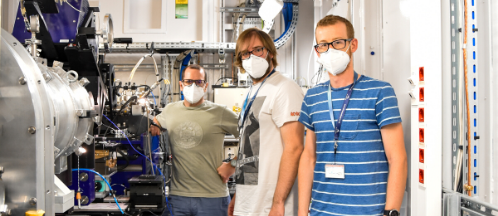
From left to right: Juan Carlos Martínez, beamline scientist at the NCD-SWEET beamline of the ALBA Synchrotron; Daniel Lucena and Juan Estévez, microtubule stabilizing agents group researchers at the Centro de Investigaciones Biológicas Margarita Salas (CIB-CSIC), all three in the beamline.
Cerdanyola del Vallès, 20th July 2020. The current COVID-19 pandemic has caused the loss of hundreds of thousands of lives, generating a huge social and economic impact around the world. Although currently there are no effective treatments available, scientists continue to work against the clock trying to find an effective treatment against the virus.
A team from the Centro de Investigaciones Biológicas Margarita Salas (CIB-CSIC) in Madrid uses synchrotron light to study the possible effect of a series of drugs currently used as antitumoral drugs, over the viral cycle of SARS-CoV-2.
The main goal is to study the effects of this set of drugs on the microtubule lattice. Microtubules are biopolymers in the form of filaments that are located inside our cells, functioning as some kind of internal framework. They intervene, among other things, in the transport of substances, one of them being the viruses.
“There is a suspicion that antitumoral drugs can inhibit viral processes, this is because they block processes that are required for the exacerbated cell growth. These same processes are the ones used by the viruses to replicate themselves inside the cell once they have taken control over its machinery.” explains Dr. Fernando Díaz, head of the microtubule stabilizing agents group, from the CIB-CSIC.
In previous analysis carried out at the ALBA Synchrotron’ XALOC and NCD-SWEET beamlines, it was demonstrated that paclitaxel, one of the most used antitumoral drugs, is capable of modulating microtubules by altering their structure.
In order to move inside the cell, viruses kidnap kinesin and dynein, motor proteins that act as transporters moving over the microtubules, using them as roads inside the cells. They hypothesized that the alteration the drug causes in the structure of the microtubules could affect the movement of this motor protein, thus interfering with the transport of the virus and blocking its replication. In addition, cytokines – proteins that intervene in the immune response – are transported inside vesicles by the same transporters, so the modulation of this movement could also affect its release, preventing the hyperactivation of the immune system, which aggravates the disease caused by the virus.
“If we succeed in this project, we would not only be fighting this particular virus, but it also could be extrapolated to others, because we want to attack a mechanism that many viruses use to move inside the cell and to get out of it. If it works, we could be before the first broad-spectrum antiviral.” adds Dr. Daniel Lucena, postdoctoral researcher of the group.
ALBA, a cutting-edge facility at the service of the scientific community
Now, the CIB-CSIC team is coming to ALBA to perform an experiment after sending a proposal through the quick access call for research projects related to SARS-CoV-2 that the Synchrotron opened. The high energy and brilliance distinctive of synchrotron light allow the acquisition of information related to size, shape and structural periodicity of microtubules in solution from their diffraction signals without freezing, staining, fixation or crystallization. Thus, the metric parameters provided by this technique are virtually similar to those of microtubules in physiological conditions.
As Juan Estévez, Ph.D. researcher of the group, comments: “using synchrotron light we can see very clearly the structure of the microtubule, which is like a fiber. Here we can see how this fiber changes its dimensions when you treat it with some compound. These changes are very small, in the order of nanometers. Which we wouldn’t be able to see with a conventional microscope.”
Once analyzed at ALBA, those drugs that cause a greater change in the structure of the microtubules will be selected to, later on, evaluate their inhibiting effect over the viral transport. The main goal of this experiment is to relate the structural changes caused by these drugs with their antiviral efficacy, aiming for a rational design of future effective antivirals against COVID-19.
“In the event that we confirm the drug has the expected effect, it could start to be used immediately, since their administration procedures and safe dosage are already known” points out Dr. Fernando Díaz.




